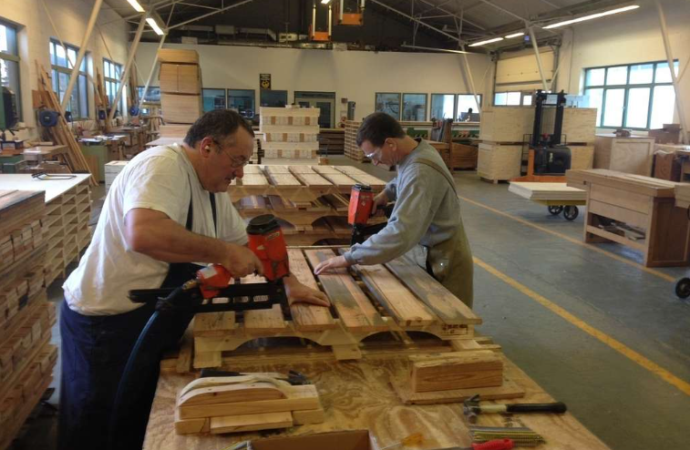“Be always employed in something useful,” wrote young Benjamin Franklin, promoting the virtue of industriousness and discouraging the wasting of time. “Cut off all unnecessary actions.” Surely, though, he did not intend that we maintain a perpetual busy-ness just for its own sake. After all, as Henry David Thoreau pointed out, “It is not enough to be industrious; so are the ants. What are you industrious about?”
Franklin undoubtedly meant that we should stay engaged in activities that make us productive members of society, advance our prosperity, and improve our character. Probably of less consideration in his era was the more contemporary notion that our work should also be personally meaningful – in other words, it should nourish our soul.
“Idleness is an enemy of the soul,” reads “The Rule of St. Benedict” for monastic living, written 1,200 years before Franklin created his famous list of 13 virtues. Though we usually think of the monastic life as contemplative and spiritual, St. Benedict believed that ora et labora – prayer and work – formed a partnership of labor that not only engaged both body and spirit, but united them as well.
For Benedictine monks, if undertaken in the right frame of mind, there is a humbling, spiritually nourishing aspect to work. Being “always employed in something useful” in this way then becomes more than just productivity, and worship becomes more than just “making long prayers filled with flatteries and compliments,” as Franklin once complained. The right labor performed in the right spirit becomes a form of worship – or, for the less religious, a form of meditation. Either way, bringing a kind of prayerful focus to our productivity adds a more meaningful dimension to it.
When I lived in the San Francisco Bay Area in the mid-1980s, I spent more than a year working full-time at the home of my friend, mentor and professor, a medievalist named George Tuma. He hired me to help him with what I gradually realized would be the never-ending process of remodeling his home.
I was a complete novice at carpentry – my previous experience wielding a hammer had been limited to putting together a few prefabricated bookcases – but that wasn’t important to him; I would acquire the basic skills quickly enough, he knew. What was important to him was that I understood the spirit of the project and brought the proper attitude for an apprenticeship.
I quickly realized that this project had more in common with the construction of a cathedral than the typical home remodeling. In the Middle Ages, the erection of a Gothic cathedral was a Herculean endeavor that sometimes took hundreds of years and involved, in one way or another, most of the community. It was possible to work one’s entire adult life on one of those extraordinary edifices of soaring stone arches and resplendent glass, seeing neither its beginning nor its completion. But its purpose was grander than any one person. Participating in raising this holy monument toward heaven was a decades-long, if not centuries-long, labor of humility, devotion, and spiritual satisfaction for generations of individuals and the community as a whole.
Like the cathedral builders and monks of the Middle Ages, the medievalist Tuma had undertaken a project that was a similar act of daily ora et labora, albeit on a much more modest and personal scale than that of a cathedral. From replacing the Spanish tiles on the roof of his single-level home to crafting a skylight to making and hanging doors, Tuma saw the ongoing construction and remodeling of his home as a lifelong partnership of prayer and industry, a reflection of the Benedictine imperative to combine both. He never intended for the work ever to be “finished” – there was always something to add or change or perfect – because that work was Tuma’s daily devotion. Each morning that he wasn’t teaching, he went to work on his home with a commitment of body and soul that was as spiritually meaningful to him as if he were constructing a cathedral. That was the spirit of his project, and that’s what I was invited to participate in, and to learn from.
Mine was an apprenticeship not only in the craft of carpentry but in this monastic focus. In his bestseller Shop Class as Soulcraft, Matthew B. Crawford shies away from acknowledging that there is a mystical dimension to craftsmanship, but anyone who has experienced the “flow” resulting from focused manual labor knows that that dimension is part of the “soulcraft,” and knows how satisfying it is.
Eventually, I moved on from Tuma’s house and out of the San Francisco Bay Area, but he continued teaching and working on his house until he passed away in 2013.
The lesson of that apprenticeship stayed with me, and it’s a lesson for all of us in a modern world which, unlike the Middle Ages, teems with technological distractions that demand our attention day and night: to make our Franklinesque busy-ness not only productive, but to bring to it a Benedictine commitment of body, mind and soul that make it spiritually meaningful.
—
The republication of this article is made possible by The Fred & Rheta Skelton Center for Cultural Renewal.
Image Credit: DVIDS, Public Domain
6 comments















6 Comments
Serge
March 14, 2025, 8:20 amA great article [url=https://intellectualtakeout.org/2025/03/ora-et-labora-making-work-meaningful/]![/url] Thank you!
REPLYMark Tapson@Serge
March 17, 2025, 8:46 pmThank YOU, Serge!
REPLYSerge
March 14, 2025, 8:20 amhttps://intellectualtakeout.org/2025/03/ora-et-labora-making-work-meaningful/
REPLYEd Bonderenka
March 14, 2025, 7:03 pmA very thoughtful piece.
REPLYIt reminds me of taking a journey.
Mark Tapson@Ed Bonderenka
March 17, 2025, 8:45 pmThanks, Ed!
REPLYCarrie Alfred
June 22, 2025, 9:27 amMy husband left me for another woman a few months ago and ever since then my life has been filled with pain and agony because my husband was my first love whom I have spent my entire life with. A friend and also a colleague from work told me he saw some testimonies of a spiritualist called Doctor Muna, he can bring back lover within some few days, Ridiculously, I laughed it out and said I am not interested but for the sake of friendship, she consulted this God sent man on my behalf and to my greatest surprise after 12 hours my husband called me for the very first time for over 7 months saying "I miss you babe and I'm so sorry for everything I made you went through" I couldn't say a word but cried over the phone and hanged up. We are back together and living Happily together again. To be honest, I still can’t believe it, because it’s highly unbelievable. Thank you DOCTOR MUNA for bringing back my love and also to my SELFLESS FRIEND. Laura, who interceded on my behalf. For anyone who might need help of this wonderful spiritualist here is the email address: [email protected], Also add him on WhatsApp: +2347035449257
REPLY